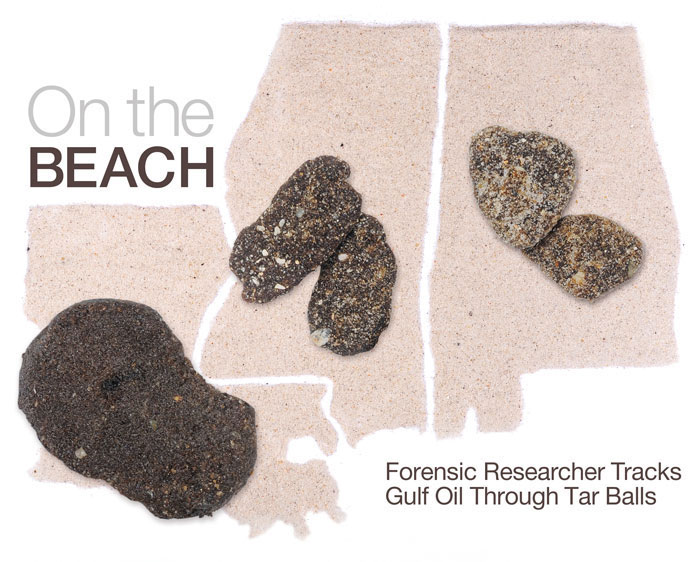|
By Matt Windsor In a plastic container on the bottom shelf of a refrigerator in her lab, Elizabeth Gardner, Ph.D., has captured the South’s Least Wanted. Gardner, a veteran forensic scientist and assistant professor of justice sciences at UAB, usually studies things like cocaine chemistry and advances in fingerprinting technology. But in February she traveled to the Alabama Gulf coast in search of a new kind of evidence to run through UAB’s high-tech forensic equipment: tar balls. After the Deepwater Horizon rig spilled millions of barrels of crude oil into the Gulf of Mexico last year, Gardner and UAB professor of biology Asim Bej, Ph.D., became interested in tracking the results at a bacterial level. Over the past several thousand years, Gardner explains, bacteria have evolved to consume the oil naturally oozing into the Gulf of Mexico from underground. “When oil seeps out, the bacteria bloom, and when the oil is gone, they die back or remain dormant,” she says. In Search of OilThe Deepwater spill sent bacterial populations into overdrive. This helped clear the oil from Gulf waters, and Gardner and Bej documented the blend of organisms that fed on the oil. But they were also interested in whether the bacterial growth itself posed any threat to marine life or to humans. (Early evidence suggests that it does not.) Earlier this year, Gardner went down to the Gulf to look for research samples. Though she had been warned not to expect to find much, she was surprised by how easily she could identify tar balls once she got the hang of it. In less than two hours, she had collected a jar of tar.
With a fridge full of samples from subsequent expeditions to beaches in Florida, Alabama, Mississippi, and Louisiana, Gardner added some new wrinkles to her project. Using the well-established literature on environmental forensics, she began analyzing her tar balls to see if they actually came from the Deepwater Horizon spill. That analysis could also help settle another sticky question: If tar balls continue to wash ashore in the coming years, are they lingering remnants of Deepwater, evidence of new spills, or the result of normal seepage? “Some people have said there have always been a few tar balls on the sand on the Gulf coast,” Gardner says. “We’ll be able to test that.” Fingerprinting Tar BallsCocaine and tar balls might appear to have little in common, but analyzing them is actually very similar, Gardner says. “Drugs are organic compounds; so is oil,” she explains. And every oil is different—it is a complex soup of organic and inorganic compounds, including hopanes and androstanes. Oil extracted from different wells will have varying levels of these molecules, which act as biomarkers, Gardner says. “If you can figure out which ones are unique to your oil sample, then you can definitively identify where the oil originated.” A definitive analysis requires equipment and expertise from a network of university, government, and private labs that Gardner has enlisted in the identification effort. She plans to make quarterly trips to the shore to collect new samples and classify them with the aid of UAB student researchers working in her lab. “I’d like to continue to monitor what’s arriving on our beaches,” Gardner says. “Most analysis is done when there’s a major issue like this spill. I’d like to see what’s there normally and establish a baseline.” |
